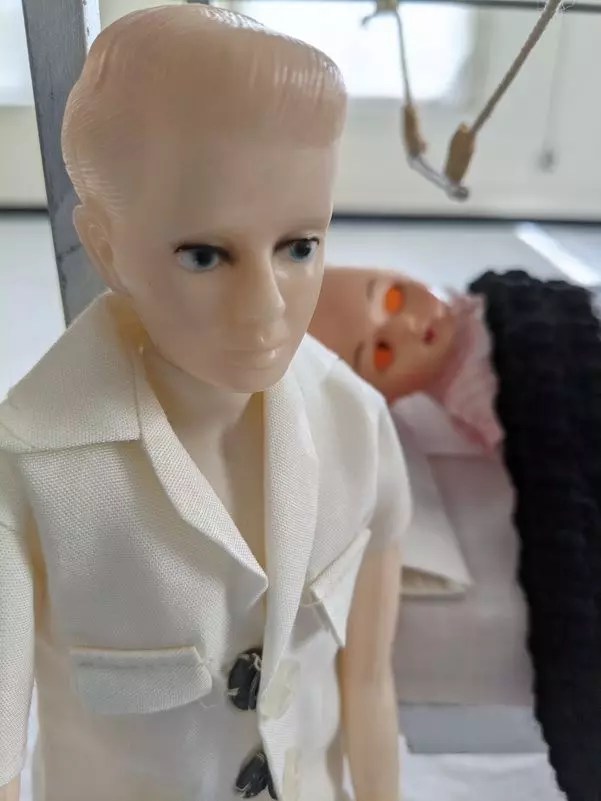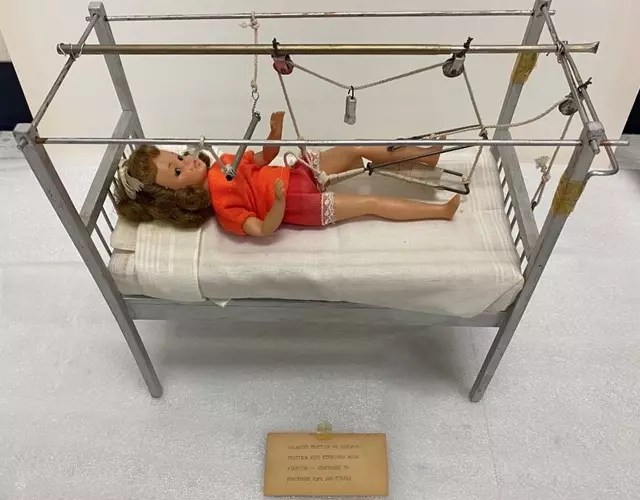In celebration of Halloween, how about we learn about some creepy dolls?
Welcome to the second edition of the Curator Corner. Happy Halloween! It’s the time of year when Childs Play is playing in a rotation with Halloween and Friday the 13th. I recently saw that USA Network was having a Chucky marathon. As a tribute to Chucky and all the dolls that make our hearts race, this edition of the Curator Corner features procedure dolls from the Mountain Home collection, a recently acquired group of early 20th century artifacts from Mountain Home VA Medical Center in eastern Tennessee. Some of these dolls are super creepy. Our graduate student intern, Amy Ackman, made them even more dreadful in the photo. This image deters the desire to work late in collection storage. Also, Amy may have an alternate career path in the horror film industry.
Some people are afraid of dolls (pediophobia), and others love them to the point of creating extensive collections. Regardless of your personal feelings about them, dolls serve a variety of essential roles as learning devices. Some people use dolls to simulate the experience of being a parent before jumping into the deep end. While not exactly a doll, instructors use manikins to show millions of people how to perform lifesaving CPR. They are also used to instruct first responders how to perform first aid. Medical professionals also use manikins to perfect their skills before working on living patients. One example is managing a patient’s airway to ensure the flow of oxygen while giving critical care.
The creepy doll contenders in our collection include 10 dolls, of varying sizes, complete with “accessories;” a bed, pulleys, ropes, and steel bars. If we didn’t know their purpose, these dolls might be considered part of a torture chamber. Fortunately, we know that these were procedure dolls, used to train Medical staff on various procedures for traction and fractures. The dolls clearly illustrate the part of the body that needs to be immobilized and the method. Each doll in the collection shows a different type of procedure.
We have been unable to find any resources that show these types of specific medical dolls were mass-produced. So, it seems likely that readily available dolls were used with custom-made furniture, hardware, and other materials to create these 3-dimensional representations of procedures that staff needed to study.
So, are the dolls still a little creepy? I believe they are, but they were also an essential part of medical care. Today medical professional use manikins and 3D prints to practice medical techniques. I don’t know about you, but I would rather have a new doctor or nurse practicing on an inanimate object instead of me.
For those of you uneasy around dolls, you can rest easy knowing that the dolls are locked up in collection storage at night.
By Kurt Senn
Curator, National VA History Center
Share this story
Related Stories
Curator Corner
It isn’t often that researchers who work with historic objects get to know the people who used those objects every day. Sometimes we get lucky and can link artifacts to certain facilities or buildings on a historic VA campus, but usually we must look for more hidden lines of evidence to figure out how an object fits into the history of those who care for our Nation’s Veterans. As nice as it would be, it isn’t as if many artifacts turn up labeled with their owners’ names! So, imagine my surprise when my teammates and I began sweeping Putnam Library for any historic objects left behind before the building is closed for renovation, and found just that.
As far as artifacts go, its story seemed simple: book presses like these would have been used to help maintain and repair the thousands of books read in Putnam Library ever since it first opened in 1879. The day that I first got up close and personal with the press, I noticed a woman’s name scraped into the black paint of the platen (the technical name for the big metal plate used to hold books together). It said “Helen Carson” in big, legible letters. As we carefully transported the heavy press down the many stairs inside Putnam Library, I looked at the name and thought “Hm…wonder who that is?”.
Curator Corner
Mary Lowell Putnam is tied to VA history by her generous donation of a large volume of books to the Central Branch of the National Home for Disabled Volunteer Soldiers. These books, meant to honor her son who died in the Civil War, helped foster reading advancement for the Veterans who lived there after the war and into the 20th Century. However, her life was more than just a moment in time donating books. It included a life-long study of languages and a very sharp opinion that she shared in writing throughout her life.
Curator Corner
Presidents George Washington and Abraham Lincoln are among the most easily recognizable figures in American history. Their faces are symbols of wisdom, strength, and leadership. Even today, polls consistently rank them as the greatest or most successful presidents. With that in mind, it is unsurprising that the appreciation of these legendary statesmen has deep historic roots. In honor of their birthdays, our team at the National VA History Center explored those roots through this pair of plaster busts.








